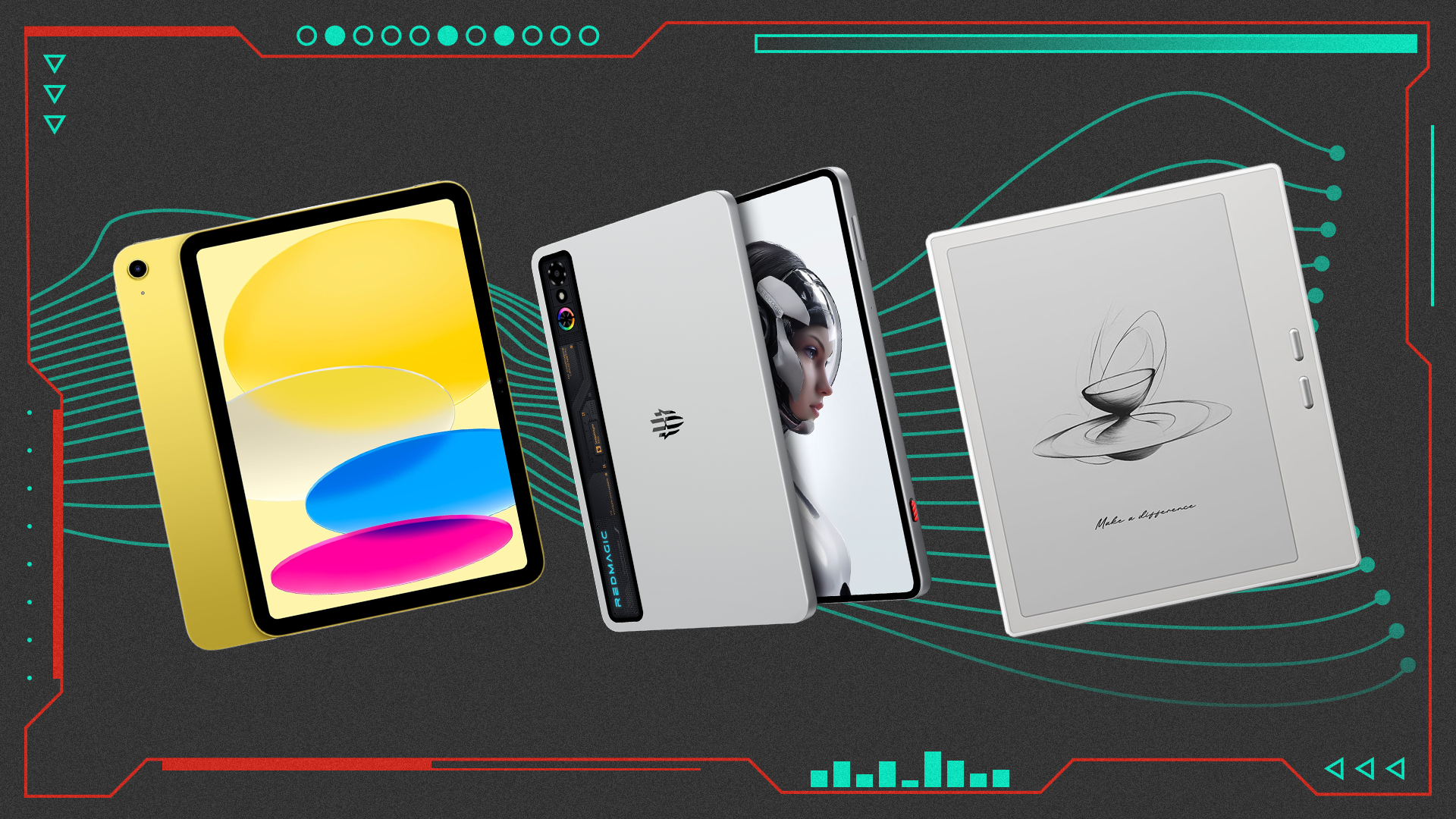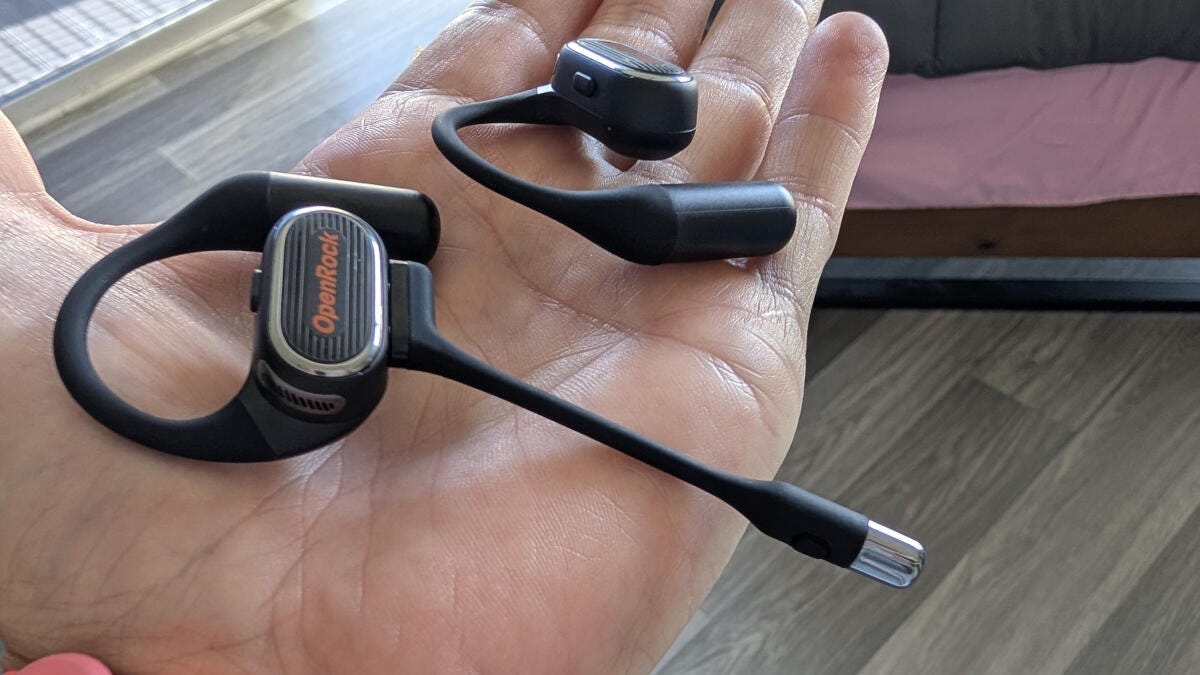The Best Tablets for Streaming, Gaming, Reading, and More


Choosing a tablet is tough, we know. Apple’s side alone has a variety of options, and it’s not always clear what’s so different between them. Unless you’re versed in all the jargon, the difference between a “Liquid Retina display” and a “Ultra Retina Tandem OLED with Pro Motion” isn’t exactly obvious. There are also major differences under the hood, with Apple currently offering devices featuring an older A16 chip at the low end and an exceedingly fast M5 chip at the high end.
Android tablets only widen the field, of course. Where Apple tends to trim off the older tablets in its stable, the Android tablet market will still readily show you devices you shouldn’t have bought when they were new, let alone years later. And just like Apple’s devices, there’s a considerable range of hardware options that go from severely underpowered to total overkill – at which point a Windows tablet could make more sense. What makes Android tablet shopping even more complicated is the software support. Apple keeps its tablets running on the latest operating systems for a long time, but how long any given Android tablet will stay up to date is a much harder question to answer.
After looking at the market, considering all the tablets we’ve tested, and weighing what actually makes sense when purchasing a tablet, we’ve narrowed down a handful of the best options that strike the right balance.
TL;DR – These Are the Best Tablets:
1. iPad (11th Generation)
Best Tablet
Apple has made finding the ideal iPad for most people quite easy over the years with its base-tier iPad generally being quite affordable while offering excellent performance and build quality. Even against competition from the Android side of the market, which has generally struggled with decent low-cost tablets, the base iPad stands out. And with the most recent 11th generation, Apple keeps the simplicity of choice going.
This new model is a very minor iteration on the 10th-gen iPad we had recommended previously. It makes very simple changes, like the shift from a 10.9-inch display to an 11-inch one, though the resolution remains unchanged. The display also continues to be 60Hz with a 500-nit peak brightness. Fortunately, none of this makes it a bad display. It even supports the Apple Pencil, albeit the same 1st-generation Apple pencil that the earlier model supported.
The internal upgrades are better. For one, the 11th-gen iPad finally does away with 64GB of base storage. It now starts with 128GB, providing a huge boost to the space you’ll have for apps, games, media, and digital creations. The chip inside also gets a bump from the dated A14 Bionic to the more recent A16 (though Apple is currently on the A19). In all, the 11th Gen iPad brings a bigger screen, more storage, and a more recent CPU all packed into a tablet that hasn’t changed its physical footprint.
See our guide to the best iPad models for more options.
2. Idea Tab Pro
Best Budget Tablet
Over the years, Lenovo has shown it knows how to make a solid more affordable tablet. You won’t have to settle for a terrible display or laggard performance here. The Lenovo Idea Tab Pro puts effort in all the right places.
For $279, you’re still getting a tablet with a metal frame and back, and a sharp, large display. The 12.7-inch display offers a 2944×1840 resolution, keeping the pixel density high. The screen is a basic LCD panel – sorry, no OLED – but provides a decent 400-nit brightness and runs at a smooth 144Hz. It also supports stylus input, and Lenovo includes said stylus in the box so you’re ready to doodle and annotate right away.
You won’t be getting flagship-tier performance, but the MediaTek Dimensity 8300 inside the Idea Tab Pro isn’t bad. It’ll keep up with everyday browsing, run streaming apps, and run light games just fine, though you won’t be firing up Genshin Impact at max settings. Perhaps more critically, the tablet supports Wi-Fi 6, so you can tap into fast networks and enjoy quality streaming. With the tablet’s large battery, you can also count on it to keep you online for long stretches.
Another big get for a low-cost tablet is software support. The Idea Tab Pro comes with Android 14 out of the box and will get updates to Android 16, and it will receive four years of security patches. That’s not mind-blowing, but getting any support like this on cheaper tablets isn’t always a given.
3. Redmagic Astra
Best Tablet for Gaming
Gaming calls for a slightly different tablet than other tasks. While some of the bigger tablets can surely still handle games, actually holding them in your hands for lengthy sessions will emphasize one of their biggest shortcomings: their weight. The Redmagic Astra is tailor-made for gaming, sitting at a more tidy 370g, less than two average smartphones. In that footprint, it manages a 9-inch OLED display that’s excellent for gaming. The panel is sharp at 1504×2400 with a 165Hz refresh rate. The color and contrast rips along smoothly in everyday operation and games alike.
To make the most of a display like that, you need powerful internals, and that’s another key aspect of the Astra. It fits the Snapdragon 8 Elite chipset I’ve seen working wonders in 2025’s top Android devices. While the Astra sadly doesn’t push the Snapdragon 8 Elite as hard as it could, it still offers excellent performance that’s a solid step above the earlier Snapdragon 8 Gen 3. Better still, it delivers consistent performance. In 3DMark’s Steel Nomad Light Stress Test, the Astra offered some of the most consistent performance I’ve seen. This is a demanding test that sees a lot of heat build up in even the best devices, and many of those will see their performance drop by anywhere from 30-50% in running it. The Astra, meanwhile, only saw its performance dip by 5.5% thanks to its capable internal cooling system.
That exceptional speed means fast-running games with their settings maxed out and no descent to slow frame rates after a half hour of gaming. I think it will be some time before Android games can bring this device to its knees, and even then, it’ll only be the most demanding new games. Now we can just hope that the PC emulation software Redmagic is working on eventually finds its way onto the Astra and Redmagic’s gaming phones.
4. OnePlus Pad 2
Best Android Tablet
I’m not convinced there’s any Android tablet worth spending $1,000 on – sorry, Samsung, but at that price you can get a competent 2-in-1 Windows machine that will have clearer longevity (like the Asus ProArt PZ13). On the other hand, many of the cheaper options raise a lot of concerns. The OnePlus Pad 2 is neither a shoddy budget Android tablet nor an unreasonably expensive one, and it brings a ton to the tablet. It pulls on its flagship-killer roots to provide a tablet that won’t leave you wanting for much more.
First, it comes packing a Snapdragon 8 Gen 3, which was the flagship chipset from Qualcomm for mobile devices until very recently and has yet to be supplanted in tablets. This gives the OnePlus Pad 2 excellent performance, and 12GB of memory helps it keep up with the multitasking you’re liable to get up to on a tablet.
The OnePlus Pad 2 packs in a sizable 12.1-inch display with a 2120×3000 resolution. It may only be an IPS panel, but it offers a 900-nit peak brightness and 144Hz refresh rate. That makes for easier visibility and smoother motion across the board. That 144Hz refresh rate can also help in the inking experience since the OnePlus Pad 2 works with a stylus that also charges while magnetically attached to the tablet.
The OnePlus Pad 2 even gets decent treatment where software is concerned. OnePlus launched on Android 14 and promised three years of OS and four years of security updates. In a market of tablets launching on outdated operating systems with next to no promise of updates, it’s refreshing to see an option that’s not destined to be outdated right out of the gate.
While the OnePlus Pad 2 launched at $550 and still proved a good value at the price, it has more often been running for $450 from OnePlus lately and usually includes a free accessory, like the folio keyboard case.
5. iPad Pro (M4, 2024)
Best Tablet for Creative Work
When I first opened the iPad Pro, I wasn’t sure what to make of it. Apple was branding it as a permanent workstation replacement, but it still wasn’t running Finder or the desktop applications I would want in that kind of device. Not long after, however, it became one of my go-to daily devices. The Tandem OLED display alone is enough to get most people hooked, even if the price tag might make you wince.
Though the chip’s power has been usurped by the iPad Pro with the M5 (which we’ll get to testing soon), the iPad Pro with an M4 is packed with an 8-core CPU clocked at 3.49GHz, which is accompanied by a 10-core GPU that will make easy work of any game you throw at it. Just keep in mind the amount of RAM you get depends on the storage configuration you go with. As long as you get a 1TB model, you’re getting a respectable 16GB of RAM, but the 512GB and 256GB models will have to make do with half the memory. If you’re not planning to use the iPad Pro for heavy creative workloads, this is going to be a non-issue. After all, iPadOS isn’t exactly known for being super memory-intensive. If you’re doing a lot of work in Photoshop or Premiere, you’re going to feel it, though.
Artists will also want to pair this tablet with the Apple Pencil Pro (or one of the myriad Apple Pencil alternatives out there). With a stylus in hand, the iPad Pro becomes an incredible creative powerhouse, even with the limits that come with working with what’s essentially a souped-up version of iOS.
6. Onyx Boox Go 7
Best for Reading
There are all kinds of great reading tablets that can do a lot more beyond turning pages on ebooks, but if you’re looking to really focus on text, you’ll be hard-pressed to find a better e-reader than the Onyx Boox Go 7.
The compact and lightweight design of the Boox Go 7 is a great match for reading, being a much better stand-in for a physical book than the large and weighty tablets that try to suggest they’ll work just as well for reading. At just 6.9oz, the Boox Go 7 is lighter than plenty of smartphones, making it a viable option for extended one-handed use. Physical buttons for turning pages on one side of the tablet (which also provides a handy grip) also make flipping through books more convenient – no covering up the screen with your thumb – and it can flip orientations.
Of course, the big advantage of the Boox Go 7 is its e-ink display, packing a sharp e-ink Carta 1300 that provides a 300ppi pixel density for crisp text. As nice as it can be to have some color added to e-ink displays, it comes with a big hit to the black-and-white contrast and overall brightness, which can make it harder to read. If you prefer a bit of color and don’t mind the trade-off, Onyx also offers a color version of this tablet. Either way, you’ll also get the advantage of a very low power draw while you’re reading, making it likely you’ll be able to get through a whole book before needing to recharge (or numerous books depending on how fast you read).
Where the Onyx Boox Go 7 sets itself apart from competitors like Amazon and Kobo is in its use of Android as its operating system. It comes with a specially tuned version of Android to work better with the e-ink display, and you still get access to the Play Store and the wide range of apps available to Android. You won’t be installing all the latest games or streaming your favorite movies on this tablet, but you can read your favorite websites in the browser, do some studying with Duolingo or Anki, and load up just about any ebook library you want, including the Kindle or Libby app. Onyx’s native e-reader app also supports a ton of formats, letting you load your own collection of ebooks onto the tablet’s built-in storage. Boox devices also have a superior default sleep screen to both Kindles and Kobos; instead of rotating ads for the latest romantasy slop or affiliate companies, Boox’s tablets rest on sketched designs.
7. Boox Tab X C
Best E-Ink Tablet
If you’re looking for an e-ink tablet, the Onyx Boox Tab X C that we reviewed is simply the best you can get right now. This is no casual e-reader with a plain black-and-white display, ultra-low refresh rate, and processing speed just fast enough to turn the pages of a digital book. The Boox Tab X C sports a large 13.3-inch E-Ink Kaleido 3 display. This includes a 3200×2400 black-and-white layer and a 1600×1200 color overlay, giving you the crisp low-power e-ink for reading and a splash of color on top to make the tablet far more versatile than typical e-ink tablets. Whether you’re browsing websites, reading comics, or annotating ebooks, that extra color comes in handy. The Boox Tab X C also has a fast enough refresh rate to feel smooth in most uses, though you probably still won’t want to game or watch videos on it.
Another big plus for the Boox Tab X C is that it runs on Android and not some proprietary e-reader OS. This means you can load up just about any app you want. Your favorite note-taking apps, your favorite ebook or comic library apps, and your favorite browsers should be right there in the Play Store ready to go.
With the big screen it provides, the Boox Tab X C can work as a great productivity aid. You can pair with a keyboard to write up documents and enjoy the extra long battery life it offers, or you can load up PDFs to both read and mark up with a stylus without needing to deal with scaling.
All of this capability comes built onto solid hardware. The tablet runs on a potent Snapdragon 855 chip, which is far more mighty than you’ll find in most e-ink devices. It’s also tucked into a classy, aluminum design.
8. iPad Air (2024)
Best Thin and Light Tablet
Apple put together a wonderful little package with the 2024 iPad Air. It upgraded from its predecessors with a thinner design, an improved selfie camera, and a newer chip under the hood. You can snag the iPad Air with either an 11- or 13-inch display, and beyond a corresponding adjustment to resolution, most of the specs of the two tablets otherwise remain the same. Either option gets you an Apple M2 chip backed by 8GB of memory. In our testing, we found this provided ample performance for everyday uses, like streaming movies and browsing, and it even held up for extended gaming sessions in Zenless Zone Zero. The thin design of the tablet can result in some heat build-up, so be mindful of that if you’re looking to do serious gaming.
The new design of the iPad Air trims its depth down to just 6.1mm, which is even thinner than an iPhone 17 and barely a half millimeter wider than the supremely slim iPhone Air. Between that and the tablet weighing just a hair over 1lb, it’s exceptionally portable. It’s also boasting a quality build with an aluminum frame and back – not that I’d expect any less from Apple.
The display on the iPad Air isn’t as bright as some of its competition, hitting 500 nits, but it offers a wide color gamut that looks great for TV and movies. It also works well with the Apple Pencil Pro, providing smooth inking for drawing and note taking. And, for those looking to incorporate the tablet into a broader device ecosystem, you’ll get the benefit of a USB-C 3.1 Gen 2 port on the bottom of the tablet, supporting faster data transfers and DisplayPort output.
While there’s a newer model with an M3 chip, the M2 model is still going to be plenty for most and can occasionally be found at a discount. (The iPad Pro will still be the more sensible option for anyone who really needs top-level specs.) Of course, if you find the M3 iPad Air at the same price or better than the M2 model, you shouldn’t hesitate to choose it instead.
How to Choose the Right Tablet for You
Budget
Figure out how much you can stomach to spend on a tablet. Looking to just stream shows and scroll socials? A cheap slate should suffice. However, you’ll need to up your spending if you’re after a productivity tool that performs similarly to a laptop. You can even slap a keyboard onto some tablets, essentially turning them into detachable laptops, albeit with the limits of their hardware and operating system.
Design and Display
You’ll want an option that’s lightweight but still durable for on-the-go use. A sizable, crisp, and responsive display ensures the best user experience, while OLED panels are a more premium option with deep blacks and richer colors over their LCD counterparts. Maybe you’d like none of the above and prefer something easier on the eyes like e-ink.
Internals
You don’t want a sluggish device that leads to you reaching for your smartphone or laptop instead. To prevent that from happening, a solid processor and at least 4GB of RAM is a must. For gaming or creative work, upgrading those specs can make a world of difference. Beyond that, you’ll want to ensure your software is up to date. Android OS is in its 16th generation, while iPadOS 26 is Apple’s latest.
Other features
Things like long battery life, great-sounding speakers, crisp cameras, and stylus support can help improve your experience on a tablet. You may even want to consider getting a 5G tablet that can connect to your cellular network when you’re not on Wi-Fi.
Tablets FAQ
Are iPads better than Android tablets?
No; they’re not worse either. Both types of tablets have plenty of solid models to choose from. It’s more a matter of personal preference. If you already have an iPhone and/or MacBook, it makes sense to grab an iPad for seamless integration into your Apple ecosystem, including the ability to double as a second screen for a MacBook. iPads are known for their smooth user experience along with their wealth of apps and games, but the pricing is more restrictive.
Tablets running on Android OS come from various manufacturers using a wide variety of components and different versions of the Android operating system, meaning performance and the experience is all over the place. But there’s a wider selection of slates, from ultra-cheap to high-end. It’s just important to do your research, as there are some duds. The selection of apps optimized for an Android tablet is also more limited. Still, almost all Android apps should function fine, just not as well as on your phone.
Should you buy a tablet with cellular network support?
Most will find that a tablet with cellular network support is unnecessary unless you’re constantly on the go with no way to connect via Wi-Fi. Adding that extra line to your cellular plan can be expensive, and your smartphone can usually work as a Wi-Fi hotspot for your tablet when you’re in a pinch. However, should you decide you’d like cellular network support, many of our picks come in 5G versions; just know you have to make that decision up front.
Jackie Thomas is the Hardware and Buying Guides Editor at IGN and the PC components queen. You can follow her @Jackiecobra.
Mark Knapp is a contributing freelancer for IGN covering everything electronics and gaming hardware. He has over 10 years of experience in the tech industry with bylines at PCMag, Reviewed, CNET, and more. Find Mark on Twitter @Techn0Mark or BlueSky at @Techn0Mark.


